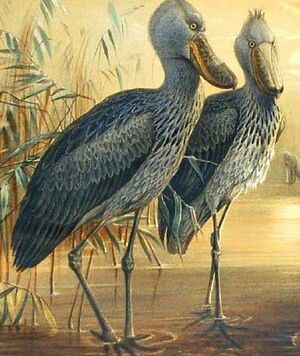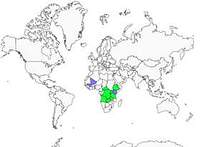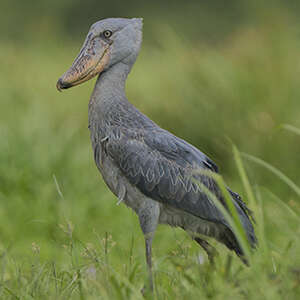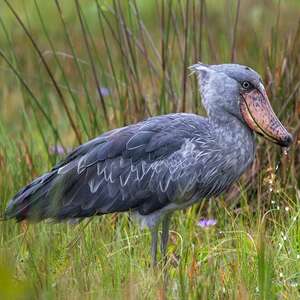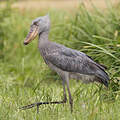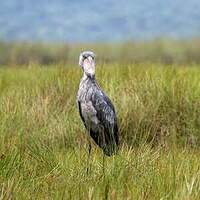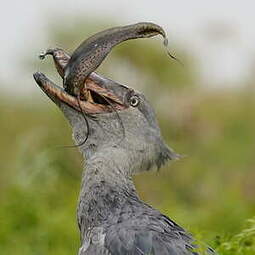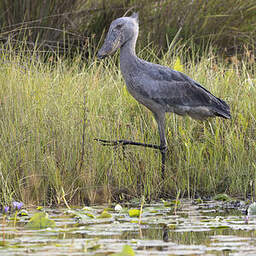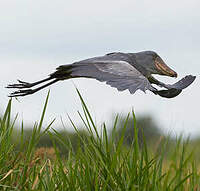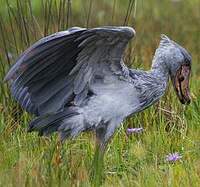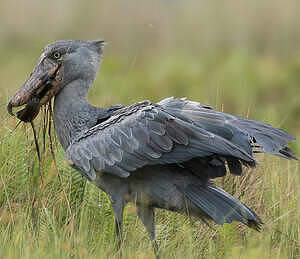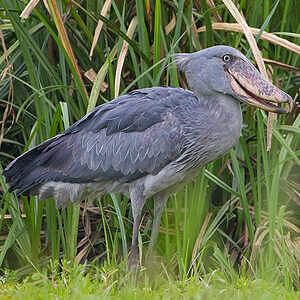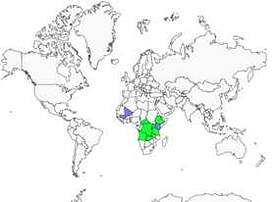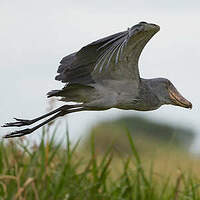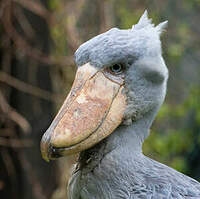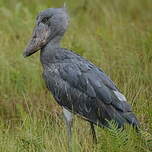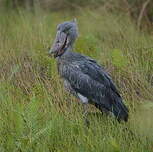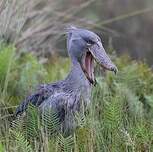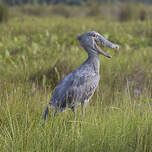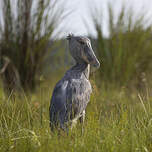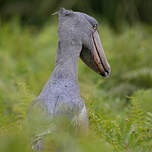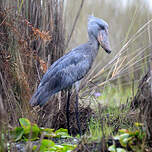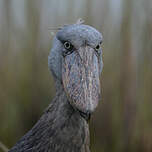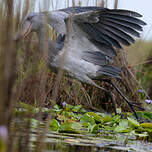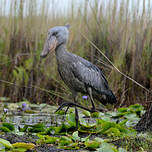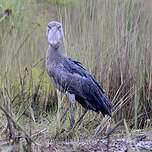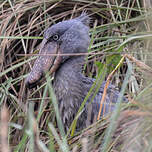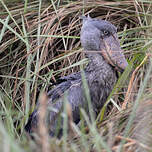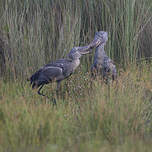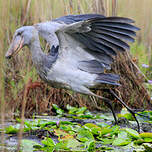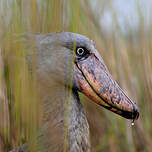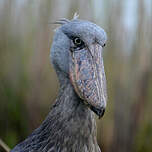Shoebill
Balaeniceps rex - Bec-en-sabot du Nil
Identification
Shoebill is a monotypic species, the only member of the family Balaenicipitidae, endemic to the African continent. Discovered and described by Westerners at the end of the 19th century, the Shoebill can seem, with its aesthetics, to come out of prehistory. Many myths and legends surround this wading bird that presents similarities (physical, anatomical, biological or behavioral) with both pelicans, marabouts, storks, Ospreys and Ardeidae (other than Ciconiiformes). DNA studies, conducted by Sibley and Ahlquist, have allowed it to be classified in the order of Pelicans.
The Shoebill's plumage remains the same all year round, ranging from gray to blue-gray. The upper coverings have an anthracite gray tendency. The ventral parts are gray, slightly lighter. Juveniles are slightly browner than adults.
Sexual dimorphism is very little marked; in fact, only a subtle difference in size and size of the beak can distinguish the two sexes. Determining the sex of an isolated bird is not possible.
The tarsi, strong and long, are finished with 4 large fingers with nails but without interdigital membranes. The whole is brownish-black. See: Video
The imposing and pyriform head presents a small tuft of feathers at the top of the occiput. The eyes, located in front of the head, allow it to have binocular vision, facilitating the detection of prey.
The color of the iris is dark yellow in the chick; this chromatic dominant attenuates to practically disappear at the age of sexual maturity. Reproductive couples have pale eyes.
The singular shape of its beak, yellowish and rosy with dark gray spots, earned it, in Sudan, the name of Abu-marqub, that is: Father of the slipper.This huge bird, with its bulbous and curved beak, is 23 cm long and 10 cm wide and has a very characteristic shape. The upper mandible has a hook, which allows for grooming, rolling eggs or holding slippery prey. Moreover, the morphology of its beak is explained as an impressive adaptation to a highly specialized method of capture. The mandibles have sharp edges to facilitate the capture and ingestion of prey. To feed at the end of the dry season, the Shoebill: exhumes protoptera* from the mud. (* Air-breathing bony fish which bury themselves in the mud when the water is running low.)
Subspecific information monotypic species
Foreign names
- Bec-en-sabot du Nil,
- Picozapato,
- bico-de-sapato,
- Schuhschnabel,
- papucscsőrű madár,
- Schoenbekooievaar,
- Becco a scarpa,
- träskonäbb,
- Treskonebb,
- člnozobec veľký,
- člunozobec africký,
- Træskonæb,
- kenkänokka,
- Skoenbekooievaar,
- bec d'esclop,
- trzewikodziób,
- Китоглав,
- ハシビロコウ,
- 鲸头鹳,
- träskonäbb,
- 鯨頭鸛,
Voice song and call
Relatively quiet, the Shoebill, like the stork, claps its beak especially during the mating season. Then it is quite noisy, the sound it makes is a powerful and hollow dokk. In-situ observations by Geneviève Renson (On the Trail of the King of the Swamp, Kubik Editions) reveal the existence of a variety of complex vocalisations (kinds of moans or meows). The young solicit food from adults with a kind of hiccupping sound.
Habitat
Behaviour character trait
The Shoebill typically occupies a territory of about 3 km² (a pair can cover up to 5 km²). It is usually solitary, so even when part of a breeding pair, the male and female will tend to feed on the opposite sides of their territory.
Loose, small groups may however occasionally form in areas where the fish resource is abundant and concentrated (dry season).In its search for food, often nocturnal, it will stride the shallow, wet areas with slow, long strides, its head bent to maximize its binocular vision. It will regularly stop to try to pinpoint a prey. Often alert, whether in the open or not, it will stiffen upon sighting it, unfold its neck, and with a sharp lunge thrusts its head into the water (wings spread to ensure balance). The capture is impressive for its speed and power. See: Video.
It does not spear like herons, but 'scoops' sideways with its distinctive bill. Plants and mud come up with the prey. A swift movement helps it to eject the superfluous, the sharp edges of the bill fatally wounding the fish or snake. It rinses its beak and drinks water afterwards. In deeper waters, it will often stand alert on a floating patch of vegetation, its long toes helping it from sinking too quickly. In densely vegetated areas, though seldom surpassing its own height, it takes advantage of the trails created by large mammals.
Flight
Like herons, the Shoebill flies with its neck tucked in. It takes off almost vertically, beating its wings heavily. Like storks, it can hover and rise on thermal currents to great heights. Head inclined, it then seems to watch its territory. It is not migratory, but isolated birds have been observed far from their original habitat.
Dietfeeding habits
Reproduction nesting
During the nesting period, which generally coincides with the beginning of the dry season, the pair is very territorial and will defend its nest against predators or potential competitors.
The breeding cycle, from nest construction to parental moulting, lasts approximately 6/7 months. The eggs are laid at the end of the wet season, and the chicks cover themselves in feathers at the end of the dry season (the decrease in water levels then facilitates access to food resources).
A 3 metre diameter zone is trampled on and cleared on emergent (or floating) vegetation or an island.
The female lays between 1 and 3 (usually 2) eggs, which are whitish in colour, and then incubated for approximately 30 days. Depending on the food resources and/or predation, only one bird will reach adulthood.
After hatching, the adults feed the chicks, which are covered in light grey downy feathers, by regurgitation.
During the hot weather, the adults regurgitate water onto the nest or the chicks in order to keep them cool. They also provide shade for the young chicks with their wing until they become feathered, around the 60th day.
See: here and here.
The young Shoebills leave the nest around day 95, but will not be able to fly until day 105/112. They will become completely independent around day 140, after which the parents will cease to feed them.
The exact age of sexual maturity is still unknown, but it is likely comparable to that of similar species such as the marabout, the stork or the pelican, around 3 or 4 years.
Geographic range
Distribution and population estimates:
- South Sudan: greater than 5,000 individuals, ranging from 50-80% of the total population
- Democratic Republic of the Congo: fewer than 1,000 individuals
- Zambia: fewer than 500 individuals
- Tanzania: 200-500 individuals
- Uganda: 100-150 individuals
- Rwanda: greater than 50 individuals
- Ethiopia: greater than 50 individuals
- Central African Republic: occasional presence
- Burundi Malawi: unknown
A recent estimate puts the total population at 5,000-8,000 individuals (T. Dodman 2002 International Wetlands). Dinesen Baker (2006) estimate a figure lower than 10,000 Shoebills (Birdlife). The population is overall declining rapidly.
Threats - protection
IUCN conservation status
concern
in the Wild
threatened
evaluated
Drainage of wetland areas for livestock or farming activity, which restricts the very specific habitats of the Shoebill, as well as poaching (for consumption or sale to zoos) are the main threats to this bird species. This rare, localized species has been classified as vulnerable (VU) by the IUCN since 2005. The Shoebill is listed in Annex II (vulnerable species subject to regulated trade) since 1987 according to CITES. It must be proposed for inclusion in Annex I. It is protected by Law in Sudan, Central African Republic, Uganda, Rwanda, Zaire and Zambia. Also included in Class A of African Convention of Nature and Natural Resources.
In areas where it is present, nature trips are also sources of income that can encourage better protection. In the last few years, various important wetlands have been included in the Ramsar Convention.
Sources of information
- IOC World Bird List (v14.2), Gill, F and D Donsker (Eds). 2024-04-18.
- Birds of Africa South of the Sahara, Ian Sinclair and Peter Ryan
- Animal Diversity Web, University of Michigan Museum of Zoology
- ARKive, Christopher Parsons
- BirdLife International, BirdLife International
- Wikipédia, Wikipedia, The Free Encyclopedia
- IUCN Red List of Threatened species,
- Sur les traces du roi des marais, Geneniève Renson
- African Bird Club,
- Encyclopedia of life,
Other sources of interest
 Specification sheet created on
29/07/2023 by Yvonnik Lhomer
Specification sheet created on
29/07/2023 by Yvonnik LhomerTranslation by AI Oiseaux.net
© 1996-2025 Oiseaux.net
- Accipitriformes
- Aegotheliformes
- Anseriformes
- Apodiformes
- Apterygiformes
- Bucerotiformes
- Caprimulgiformes
- Cariamiformes
- Casuariiformes
- Charadriiformes
- Ciconiiformes
- Coliiformes
- Columbiformes
- Coraciiformes
- Cuculiformes
- Eurypygiformes
- Falconiformes
- Galliformes
- Gaviiformes
- Gruiformes
- Leptosomiformes
- Mesitornithiformes
- Musophagiformes
- Nyctibiiformes
- Opisthocomiformes
- Otidiformes
- Passeriformes
- Pelecaniformes
- Phaethontiformes
- Phoenicopteriformes
- Piciformes
- Podargiformes
- Podicipediformes
- Procellariiformes
- Psittaciformes
- Pterocliformes
- Rheiformes
- Sphenisciformes
- Steatornithiformes
- Strigiformes
- Struthioniformes
- Suliformes
- Tinamiformes
- Trogoniformes

